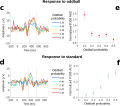P300 (neuroscience)
P300 (neuroscience)
The P300 is a component of the human event-related potential (ERP) that is elicited in the process of decision making. It is considered to be an electroencephalography (EEG) measure of human cognitive function and is most commonly elicited in an "oddball" paradigm when a person experiences rare, unexpected stimuli.
Overview[edit]
The P300 wave is a positive deflection in voltage with a latency of roughly 250 to 500 milliseconds. The exact latency can vary according to the specifics of the stimuli and task. The P300 is most commonly observed from scalp electrodes overlaying the parietal lobe.
Generation[edit]
The generation of the P300 is thought to involve several cortical and subcortical structures, including the hippocampus, basal ganglia, and thalamus. The exact mechanisms underlying the P300 are still not fully understood, but it is thought to reflect processes involved in stimulus evaluation or categorization.
Clinical significance[edit]
The P300 has been used in clinical contexts to assess cognitive function in various neurological and psychiatric conditions, including Alzheimer's disease, schizophrenia, and depression. It has also been used in forensic contexts, such as in the detection of deception or recognition of familiar stimuli in eyewitness testimony.
See also[edit]
References[edit]
<references group="" responsive="1"></references>

This article is a neuroscience stub. You can help WikiMD by expanding it!
-
P300 latency and amplitude trajectories across the lifespan
-
P300 response of different subjects
-
P300 vs oddball probability
Ad. Transform your life with W8MD's Budget GLP-1 injections from $75


W8MD offers a medical weight loss program to lose weight in Philadelphia. Our physician-supervised medical weight loss provides:
- Weight loss injections in NYC (generic and brand names):
- Zepbound / Mounjaro, Wegovy / Ozempic, Saxenda
- Most insurances accepted or discounted self-pay rates. We will obtain insurance prior authorizations if needed.
- Generic GLP1 weight loss injections from $75 for the starting dose.
- Also offer prescription weight loss medications including Phentermine, Qsymia, Diethylpropion, Contrave etc.
NYC weight loss doctor appointmentsNYC weight loss doctor appointments
Start your NYC weight loss journey today at our NYC medical weight loss and Philadelphia medical weight loss clinics.
- Call 718-946-5500 to lose weight in NYC or for medical weight loss in Philadelphia 215-676-2334.
- Tags:NYC medical weight loss, Philadelphia lose weight Zepbound NYC, Budget GLP1 weight loss injections, Wegovy Philadelphia, Wegovy NYC, Philadelphia medical weight loss, Brookly weight loss and Wegovy NYC
|
WikiMD's Wellness Encyclopedia |
| Let Food Be Thy Medicine Medicine Thy Food - Hippocrates |
Medical Disclaimer: WikiMD is not a substitute for professional medical advice. The information on WikiMD is provided as an information resource only, may be incorrect, outdated or misleading, and is not to be used or relied on for any diagnostic or treatment purposes. Please consult your health care provider before making any healthcare decisions or for guidance about a specific medical condition. WikiMD expressly disclaims responsibility, and shall have no liability, for any damages, loss, injury, or liability whatsoever suffered as a result of your reliance on the information contained in this site. By visiting this site you agree to the foregoing terms and conditions, which may from time to time be changed or supplemented by WikiMD. If you do not agree to the foregoing terms and conditions, you should not enter or use this site. See full disclaimer.
Credits:Most images are courtesy of Wikimedia commons, and templates, categories Wikipedia, licensed under CC BY SA or similar.
Translate this page: - East Asian
中文,
日本,
한국어,
South Asian
हिन्दी,
தமிழ்,
తెలుగు,
Urdu,
ಕನ್ನಡ,
Southeast Asian
Indonesian,
Vietnamese,
Thai,
မြန်မာဘာသာ,
বাংলা
European
español,
Deutsch,
français,
Greek,
português do Brasil,
polski,
română,
русский,
Nederlands,
norsk,
svenska,
suomi,
Italian
Middle Eastern & African
عربى,
Turkish,
Persian,
Hebrew,
Afrikaans,
isiZulu,
Kiswahili,
Other
Bulgarian,
Hungarian,
Czech,
Swedish,
മലയാളം,
मराठी,
ਪੰਜਾਬੀ,
ગુજરાતી,
Portuguese,
Ukrainian



